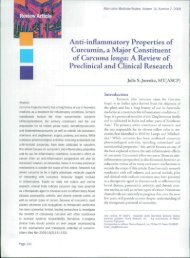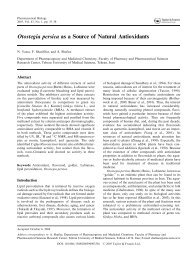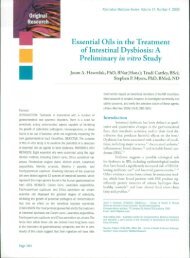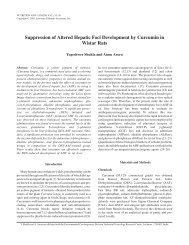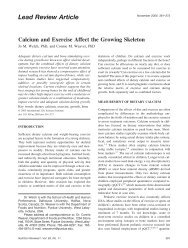Why Aging People Become DEPRESSED, FATIGUED, and ...
Why Aging People Become DEPRESSED, FATIGUED, and ...
Why Aging People Become DEPRESSED, FATIGUED, and ...
- No tags were found...
You also want an ePaper? Increase the reach of your titles
YUMPU automatically turns print PDFs into web optimized ePapers that Google loves.
BY WILLIAM FALOON<br />
<strong>Why</strong> <strong>Aging</strong> <strong>People</strong> <strong>Become</strong><br />
<strong>DEPRESSED</strong>, <strong>FATIGUED</strong>,<br />
<strong>and</strong> OVERWEIGHT<br />
Serotonin is a compound in the brain that promotes feelings of personal<br />
security, relaxation, <strong>and</strong> confidence. A serotonin deficiency can result in sleep<br />
disturbance, anxiety, depression, <strong>and</strong> a propensity to overeat, particularly<br />
carbohydrates like simple sugars.<br />
Startling research reveals that serotonin levels decline as we age!' * These<br />
findings provide a biochemical rationale to explain common age-related<br />
disorders such as depressed mood <strong>and</strong> sleep difficulties. Based on these<br />
discoveries, aging people may appreciably improve their health by restoring<br />
serotonin to youthful levels.<br />
The amino acid tryptophan is needed to produce serotonin in the brain."<br />
While the amount of tryptophan in a typical diet meets basic metabolic<br />
requirements, it often fails to provide optimal brain serotonin levels.<br />
Ever since the FDA restricted the importation of tryptophan for use in<br />
dietary supplements, there has been an upsurge in the percentage of<br />
overweight <strong>and</strong> obese Americans.<br />
One could argue that a widespread serotonin defidency is at least partially<br />
responsible for the record numbers of depressed, sleep-deprived, <strong>and</strong><br />
overweight individuals. > ><br />
COLLECTOR'S EDITION 2009 LIFE EXTENSION I 45
WHY AGING PEOPLE BECOME <strong>DEPRESSED</strong>, <strong>FATIGUED</strong>, AND OVERWEIGHT<br />
<strong>Why</strong> Dietary Tryptophan Is Inadequate<br />
Tryplophan is one of the eight essential amino<br />
acids found in the human diet. Essential amino acids<br />
ai e defined as those that cannot be made in the body<br />
<strong>and</strong> therefore must be obtained fi-om food or supplements.<br />
(A ninth amino acid, histidine, is sometimes<br />
considered essential for children.)<br />
Our bodies do need additiomil amino acids, but<br />
these other amino acids are made from the eight<br />
essential amino acids when we are in optimal health.<br />
In any normal diet, be it omnivorous or vegetarian,<br />
tiyptophan is the least plentiful of all amino acids.<br />
A typical diet provides only 1,000 to 1,500 mg/day of<br />
tryptophan, yet there is much competition in the body<br />
for this scarce tiyptophan.<br />
Tryptophan is used to make various protein structures<br />
of the body. In people with low-to-moderate<br />
intakes of vitamin B3 (niacin), tryptophan may be<br />
used to make B3 in the liver at the astounding ratio of<br />
60 mg ti-yptophan to make just 1 mg of vitamin B3.^<br />
Yet even maintaining a minute amount of tiyptophan<br />
provides little benefit in boosting serotonin in the<br />
brain due to competition with other amino acids for<br />
transport through the blood-brain barrier. Nutrients<br />
must be taken up through the blood-brain barrier by<br />
transport molecules. Tiyptophan competes for these<br />
transport molecules with other amino acids.<br />
As one can see, diet-derived tiyptophan contributes<br />
very little actual tryptophan to the brain. As you will<br />
soon read, even eating tiyptophan-containing foods<br />
like turkey may not always provide the body with<br />
enough of this essential amino acid. One reason is<br />
that aging people make enzymes that rapidly degrade<br />
tryptophan in the body.<br />
The Human Body<br />
Requires the Following Eight<br />
Essential Amino Acids:<br />
Tryptophan<br />
Lysine<br />
Methionine<br />
Phenylalanine<br />
Threonine<br />
Valine<br />
Isoleucine<br />
Leucine<br />
Essential amino acids cannot be made in the<br />
body <strong>and</strong> therefore must be obtained from food or<br />
supplements. {Children may require the amino acid<br />
histidine in addition to those listed above.)<br />
Remember, tryptophan is the only normal dietary<br />
raw material ior serotonin synthesis in the brain. Given<br />
all we now know about the difficulty in maintaining<br />
adequate tryptophan status, is it any wonder that so<br />
many aging humans suffer from disorders such as<br />
depression, insomnia, <strong>and</strong> excess weight gain associated<br />
with a serotonin deficiency<br />
How Tryptophan Functions in the Body<br />
L-tiyptophan converts into serotonin, primarily<br />
in the brain. Since serotonin is a neurotransmitter<br />
involved in controlling moods <strong>and</strong> appetite, tiyptophan<br />
supplementation has been recommended for<br />
individuals suffering from a variety of conditions<br />
associated with decreased serotonin levels, including<br />
sleep disorders, depression <strong>and</strong> fibromyalgia, <strong>and</strong> eating<br />
disorders."'*<br />
It has been shown in human clinical studies that<br />
low levels of tiyptophan contribute to insomnia."<br />
Increasing tryptophan may help to normalize sleep<br />
patterns.'" '^ It is known that raising tryptophan levels<br />
in the body may decrease cravings <strong>and</strong> binge eatings<br />
especially for carbohydrates—<strong>and</strong> help people lose<br />
weight.'"'*<br />
L-tryptophan serves as a precursor not only to<br />
serotonin, but also melatonin <strong>and</strong> niacin. Serotonin is<br />
a major neurotransmitter involved in many somatic<br />
<strong>and</strong> behavioral functions including mood, appetite<br />
<strong>and</strong> eating behavior, sleep, anxiety, <strong>and</strong> endocrine<br />
regulation.'"'"^"<br />
46 I LIFE EXTENSION I COLLECTOR'S EDITION 2009
There are two possible sources for L-tryptophan:<br />
diet <strong>and</strong> tissue proteins, from which L-tryptophan has<br />
been recycled during protein turnover. <strong>Aging</strong>, chronic<br />
inflammatory diseases, <strong>and</strong> HIV infection are associated<br />
with tiyptophan depletion, even in the absence<br />
of dietaiy tryptophan deficiency.<br />
An adult male needs 250 mg a day of tiyptophan<br />
just to maintain nitrogen balance."* While a normal<br />
diet contains 1,000 to 1,500 mg of ti-yptophan per<br />
day,'" the enzymatic breakdown of tryptophan<br />
increases with age,^*^ <strong>and</strong> certain disease states can<br />
severely deplete tiyptophan.<br />
How Tryptophan is Metabolized in the Body<br />
There are three potential fates for L-tryptophan<br />
once ingested:<br />
• Incorporation into body tissue proteins.<br />
• Conversion into serotonin (<strong>and</strong> melatonin).<br />
• Conversion into indoleamines, carbon<br />
dioxide, water, adenosine triphosphate (ATP),<br />
<strong>and</strong> niacin.^'<br />
For every nutrient absorbed into the body, there are<br />
specific enzymes that convert the nutrient into other<br />
substances. There are two specific enzymes that can<br />
deprive the body of sufficient amounts of tryptophan.<br />
These enzymes are called L-tryptophan 2,3-dioxygenäse<br />
(TDO) <strong>and</strong> indoleamine 2,3-dioxygenase (IDO).<br />
The liver enzyme TDO is induced when plasma<br />
concentrations of L-tryptophan exceed those needed<br />
for conversion into serotonin <strong>and</strong>/or protein. This<br />
enzyme oxidizes surplus L-tiyptophan into carbon<br />
dioxide, water, <strong>and</strong> ATP.-^"<br />
The other tryptophan-degrading enzyme IDO is<br />
more insidious because it can degrade L-tryptophan<br />
even when circulating levels of L-tryptophan are<br />
This enzyme has been found outside the liver on<br />
macrophages <strong>and</strong> dendritic cells <strong>and</strong> is increased in<br />
pro-inflammatory states, HIV infection, <strong>and</strong> normal<br />
Once the TDO or IDO enzymes act on tryptophan,<br />
it is no longer available for conversion to serotonin or<br />
incorporation into protein. Consuming large amounts<br />
of oral L-tryptophan will not generate more serotonin<br />
because more TDO will be induced to deplete the<br />
ti'yptophan.<br />
Ti-yptophan <strong>and</strong> its metabolite 5-hydroxytryptophan<br />
(5-HTP) are taken up into the brain across the bloodbrain<br />
barrier by a transpori system that is active<br />
towards all ihe large neutralamino acids.^^ The affinity<br />
of the various amino acids for the canier is such that<br />
there is competition between the large neutral amino<br />
acids for enti-v into brain. In fact, the best predictor<br />
Tryptophan<br />
Serotonin is a brain biochemical that<br />
promotes restful sleep, well-being, <strong>and</strong> satiety.<br />
When serotonin levels are low, people often<br />
experience depression, anxiety, insomnia, <strong>and</strong><br />
the urge to overeat.<br />
The amino acid tryptophan is needed to<br />
produce serotonin in the body. While foods<br />
contain some tryptophan, the diet may not<br />
provide enough tryptophan to make adequate<br />
amounts of serotonin. Additionally, enzymes<br />
that are influenced by inflammation <strong>and</strong> aging<br />
can break down tryptophan before it converts<br />
to serotonin.<br />
Individuals suffering from the adverse effects<br />
of low serotonin levels can now restore sleep,<br />
appetite control, <strong>and</strong> mood by supplementing<br />
with an advanced L-tryptophan formulation.<br />
This formula combines L-tryptophan with<br />
nutrients <strong>and</strong> herbs that help optimize its<br />
ability to convert to beneficial serotonin in<br />
order to counteract appetite <strong>and</strong> sleep<br />
disorders, <strong>and</strong> low mood.<br />
COLLECTOR'S EDITION 2009 | LIFEEXTENSION | 47
WHY ACINC PEOPLE BECOME <strong>DEPRESSED</strong>, <strong>FATIGUED</strong>, AND OVERWEIGHT<br />
Cytokines<br />
(e.g. IFN)<br />
FIGURE 1. Metabolic Pathways of L-Tryptophan.<br />
The enzymes <strong>and</strong> cofactors involved in the reactions<br />
are listed next to the bold arrows, the dashed<br />
arrows, <strong>and</strong> the plus <strong>and</strong> minus signs indicate<br />
increases or decreases in the metabolites shown.<br />
Abbreviations:<br />
AADC: aromatic amino acid<br />
decarboxylase;<br />
B6: pyridoxine;<br />
BH4: L-erythro-tetrahydrobiopterin;<br />
5-HtAA: 5-hydroxyindoleacetic acid;<br />
5-HTP: 5-hydroxytryptophan;<br />
IDO: indoleamine 2,3-dioxygenase;<br />
IFN: interferon;<br />
TDO: tryptophan 2,3-dioxygenase;<br />
TPH: tryptophan hydroxylase.<br />
of a given meal's effect on brain tiyptopban-serotonin<br />
levels is tbe serum ratio of tryptophan to the pool of<br />
large neutral amino acids.'^^<br />
More clinically relevant, bowever, is tbat serotonin<br />
levels are enbanced by carbohydrate ingestion.^'' Tbe<br />
reason is tbat tbe bigb amount of insulin released in<br />
response to carbohydrate ingestion accelerates the<br />
serum removal of valinc, leucinc, <strong>and</strong> isoleucine that<br />
compete against ti^ptophan lor transport into the<br />
brain. Similarly, a higher percentage of protein in the<br />
diet slows serotonin elevation (by providing competing<br />
amino acids for the blood-brain barrier).'** "<br />
Giving tryptophan with an inhibitor of the TDO<br />
enzyme would enable lower doses of tryptophan to<br />
be used. In the rat, high doses of pyridoxine (vitamin<br />
B6) can inhibit tryptophan catabolism in the liver <strong>and</strong><br />
increase uptake of tryptophan into the brain.^'' While<br />
the effect of high doses of pyridoxine on plasma tryptophan<br />
has not been studied in humans, pyridoxine<br />
.should be given with tryptophan for another reason.<br />
When tiyptophan was given to normal subjects for a<br />
week, levels of tryptophan metabolites in the plasma<br />
increased indicating that tiyptophan was being broken<br />
down. This effect could be attenuated by pyi idoxine<br />
(pyridoxine assists the breakdown of the tryptophan<br />
metabolite kynurenine, which can compete with tryptophan<br />
for uptake into the brain), suggesting that<br />
chronic tryptophan treatment increases pyridoxine<br />
requirements.^'<br />
Clinical Implications: SLEEP DISORDERS<br />
Tiyplophan has been researched for sleep disorders<br />
for 30 years. Improvement of sleep normalcy has<br />
been noted^" at doses as low as 1,000 mg.'^ Increased<br />
stage 4 sleep has been noted at even lower doses—<br />
as low as 250 mg tiyptophan.'" Significant improvement<br />
in obstructive sleep apnea, but not central sleep<br />
apnea, has been noted at doses of 2,500 mg at bedtime,<br />
with those experiencing the most severe apnea demonstrating<br />
the best response.^'' While many sedative<br />
medications have opioid-Iike effects, L-tiyptophan<br />
administration does not limit cognitive performance<br />
or inhibit arousal from sleep.''"<br />
L-tryptophan depletion negatively impacts sleep. A<br />
significant decrease in serum tryptophan levels after a<br />
tryptophan-free amino acid drink was associated with<br />
an adverse effect upon sleep parameters (stage 1 <strong>and</strong><br />
stage 2 time, <strong>and</strong> rapid eye movement sleep time).'*<br />
L-tryptophan is not associated with tolerance or difficulty<br />
with morning wakening <strong>and</strong> has been shown<br />
to be efficacious for sleep in several clinical trials of<br />
various designs <strong>and</strong> L-tryptophan dosages.<br />
DEPRESSION<br />
As previously mentioned, L-tryptophan is essential<br />
for the brain to synthesize serotonin, a neurotransmitter<br />
that has been shown to affect mood. Several studies<br />
have shown that acute tryptophan depletion can cause<br />
a depressive state in humans, especially patients who<br />
48 I LIFE EXTENSION I COLLECTOR'S EDITION 2009
WHY AGING PEOPLE BECOME <strong>DEPRESSED</strong>, <strong>FATIGUED</strong>, AND OVERWEIGHT<br />
are in remission from depression.""'^^ In a study of the<br />
effects oiacute tryptophan depletion on healthy women<br />
<strong>and</strong> patients v^/ith bulimia nervosa, both groups were<br />
given amino acid mixtures to consume to decrease their<br />
plasma tryptophan levels. In both groups an increase<br />
in depression occuned."*^<br />
Plasma L-tryptophan levels can be raised through<br />
dietary intake of L-tryptophan, which raises serotonin<br />
levels in the brain, <strong>and</strong> thereby lessens the depressive<br />
state.** In a study involving recovering alcoholic<br />
patients, it was found that the participants had severely<br />
depleted L-tryptophan levels accompanied by a high<br />
level of depressive state. When the patients were given<br />
supplemental doses of L-tryptophan over a short period<br />
of time, their depressive state lessened significantly.""^<br />
The tryptophan metabolite, 5-hydroxytryptophan<br />
(5-HTP), has shown significant clinical response for<br />
depression in 2-4 weeks, at doses of 50-300 mg three<br />
times daily/''•*'^<br />
PREMENSTRUAL SYNDROME<br />
A daily dose of 6,000 mg of L-tryptophan significantly<br />
decreased mood swings, tension, <strong>and</strong> irritability<br />
in women with premenstrual syndrome.'*^ The metabolism<br />
of tiyptophan is impacted by the different<br />
phases of a woman's cycle,''" <strong>and</strong> therefore hormonal<br />
changes during the menstrual cycle may negatively<br />
affect the availability of ti'yptophan for conversion<br />
into serotonin.<br />
CARBOHYDRATE CRAVINGS<br />
AND WEIGHT LOSS<br />
Some obese people consume carbohydrate-rich<br />
foods frequently <strong>and</strong> preferentially, because they have<br />
a persistently low plasma tryptophan ratio, as well as<br />
low tryptophan uptake into the brain.^' Remember<br />
that serotonin levels are enhanced by carbohydrate<br />
ingestion as insulin release accelerates the serum<br />
removal of other amino acids that compete for transport<br />
through the blood-brain barrier.<br />
Increasing the L-tryptophan levels in blood plasma<br />
is also known to have an appetite-suppressing effect<br />
that mainly impacts carbohydrate consumption."'^^<br />
Presumably the supplemental tryptophan would<br />
enhance the release of serotonin from brain neurons to<br />
diminish appetite for carbohydrates, which helps with<br />
loss of body weight. In addition, obese subjects are<br />
often insulin-resistant, <strong>and</strong> diminished insulin action<br />
may cause low plasma tryptophan ratios^^ because of<br />
the peripheral effects of insulin on the uptake <strong>and</strong> utilization<br />
of other amino acids.<br />
A study was done to measure L-tryptophan in the<br />
blood plasma of obese patients to assess the plasma<br />
tryplophan ratio to large neutral amino acids<br />
(tyrosine -^ phenylalanine -t- leucine -f isoleucine -tvaline).<br />
The results showed the plasma tryptophan<br />
ratio was well below the normal ratio for humans.^'<br />
If elevation of the tryptophan in relation to large<br />
neutral amino acids occurs, more tryptophan is<br />
allowed into the brain to induce serotonin synthesis<br />
<strong>and</strong> influence functions of serotonin (mood, appetite,<br />
sleep, <strong>and</strong> hunger). This study helps show why<br />
obese people often have uncontrollable appetites,<br />
i.e., they have too little tryptophan in relation to<br />
other large neutrat amino adds in their blood.<br />
COLLECTOR'S EDITION 2009 I LIFE EXTENSION I 49
WHY AGING PEOPLE BECOME <strong>DEPRESSED</strong>, <strong>FATIGUED</strong>, AND OVERWEIGHT<br />
When these obese patients were given 1,000 mg,<br />
2,000 mg, or 3,000 mg doses of L-ti7ptophan one<br />
hour before meals to raise tbe amount of tryptophan<br />
relative to the large neutral amino acids, a significant<br />
deerease in calorie consumption was obsei^ved. The<br />
majority of the reduction in ealoric intake was due<br />
to the amount of carbohydrates, not protein, consumed.<br />
The only side effects observed were a mild<br />
decrease in mental alertness, mild dizziness, <strong>and</strong><br />
mild drowsiness.^''<br />
In a double-blind, placebo-controlled study,<br />
obese patients on protein-rich diets who received<br />
tryptophan (750 mg twice daily orally) had significant<br />
weight loss, compared with a placebo group. A<br />
moderate dose of ti^ptophan supplementation did<br />
not cause any side effects such as mid-day sleepiness<br />
or fatigue." The effects of reducing tryptophan levels<br />
were also studied in a 7-year-old girl with severe<br />
anorexia. When tryptophan levels were reduced,<br />
spontaneous eating occurred for the first time in<br />
4.5 years. The spontaneous eating ceased when the<br />
tryptophan intake was increased.^''<br />
How <strong>Aging</strong> Reduces<br />
Tryptophan-Serotonin Levels<br />
As a result of normal aging, inflammatory cytokine<br />
levels increase. A little-known adverse effect is that<br />
inflammatory cytokines (such as tumor necrosis<br />
factor alpha <strong>and</strong> interferon alpha) cause induction<br />
of the tryptophan-degrading enzyme IDO<br />
{indoleamine 2,3-dioxygenase).<br />
You might think that aging people could compensate<br />
for the tryptophan-degrading effects of IDO by<br />
consuming higher doses of tiyptophan supplements.<br />
The problem is that in the presence of high blood<br />
levels of tr>'ptophan, the other tryptophan-degrading<br />
enzyme TDO is also elevated.<br />
So consuming large amounts of L-tryptophan (oral<br />
doses of 4,000 mg <strong>and</strong> greater) will not generate more<br />
serotonin because TDO will be induced. Yet if aging<br />
people fail to get more tryptophan into their bodies,<br />
brain serotonin levels will plummet because the higher<br />
IDO enzyme activity will degrade what little tiyptophan<br />
remains in the blood.<br />
Engineering Around This Problem<br />
Fortunately, the new underst<strong>and</strong>ing of how tryptophan<br />
is degraded in aging humans provides a basis for<br />
engineering a natural solution around this epidemic<br />
problem.<br />
First of all, we know from studies in patients with<br />
high levels of systemic inflammation that if sufficient<br />
niacinamide is given, the degradation of tryptophan<br />
in the body is significantly reduced."'^" We also know<br />
that the amino acid lysine competes with tiyptophan<br />
in the same oxidative degradation pathway. This<br />
means that in the presence of lysine, less tryptophan<br />
is oxidized.^^<br />
Tryptophan, however, can still be degraded by the<br />
IDO enzyme that increases as humans age. Nutrients<br />
such as curciimin inhibit interferon-induced nuclear<br />
factor-kappa-B <strong>and</strong> COX-2 expression <strong>and</strong> may limit<br />
the induction of IDO, thus making more tryptophan<br />
available for conversion to serotonin in the brain.'^'<br />
UFE EXTENSION I COLLECTOR'S EDITION 2009
WHY AGING PEOPLE BECOME <strong>DEPRESSED</strong>, <strong>FATIGUED</strong>. AND OVERWEIGHT<br />
Evening oral doses of tryptophan as low as 250 mg<br />
have been shown to improve sleep quality, although<br />
the typical dosage range for sleep disorders <strong>and</strong> depression<br />
is 1,000-3,000 mg daily. Safe <strong>and</strong> effective dosages<br />
for other disorders range ft-om 500 mg to 4,000 mg/day,<br />
while doses around 3,500 mg/day have been used short<br />
term as a smoking cessation intervention.*^<br />
Tryptophan is oxidized in the liver by tryptophan-<br />
2,3-dioxygenase (TDO), an enzyme that is induced<br />
both by glucocorticoids <strong>and</strong> by large doses of tryptophan<br />
itself. The enzyme activity of TDO increases<br />
after tryptophan administration^^ <strong>and</strong> results in a relatively<br />
short half-life of tryptophan remaining in the<br />
plasma.''^ Thus, tiyptophan is often given in divided<br />
daily doses instead of a single dose. A single dose of<br />
3,000 mg is sufficient to keep human brain serotonin<br />
synthesis maximized for about eight to twelve hours.''^<br />
Giving three daily doses of 2,000 mg will probably<br />
keep the rate-limiting tiyptophan hydroxylase enzyme<br />
in the brain fully saturated for most of each 24-hour<br />
period, meaning that brain serotonin levels would be<br />
maintained at a constant optimal level.<br />
It is thus possible for aging people to supplement<br />
with a modest dose of tryptophan ( 1,000-1.500 mg per<br />
day) <strong>and</strong> significantly decrease tiyptophan oxidation/<br />
degradation, as long as lysine, niacinamide, <strong>and</strong> the<br />
proper cytokine-suppressing nutrients are taken with<br />
it to neutralize the effects of the IDO enzyme.<br />
Cofactors that facilitate the conversion of tryptophan<br />
to serotonin in the brain are vitamin B6. magnesium,<br />
<strong>and</strong> vitamin C.""" These nutrients are already<br />
taken by most health-conscious people.<br />
Dosage<br />
An important factor in the decision to supplement<br />
with L-tnptophan is its excellent tolerability <strong>and</strong> the<br />
lack of development of tolerance during long-term use.<br />
Furthermore, L-tryptophan does not cause difficulties<br />
when tidying to wake up the next morning.*"^<br />
The minimal dose of L-ti^ptophan for effective<br />
treatment of insomnia may be at least 1,000 mg, <strong>and</strong><br />
repeat administration of L-tiyptophan may be required<br />
for improvement in chronic, well-established, sleeponset<br />
insomnia or insomnia characterized by both<br />
sleep-onset <strong>and</strong> sleep-maintenance abnormalities.^'<br />
Low doses of L-tiyptophan (250 to 500 mg) may not<br />
offer a significant benefit on sleep latency.'"'For those<br />
with insomnia wlio wish to try L-tryptophan, a strong<br />
initial dose (1,000 to 4,000 nig) is recommended for<br />
the first week, followed by a lower maintenance dose<br />
(500mg to 1,000 mg).<br />
Tryptophan Blackout Is Lifted!<br />
American consumers can once again obtain tryptophan<br />
as a dietary supplement. Particularly compelling<br />
news is the discovery that aging people produce tryptophan-degrading<br />
enzymes, which can be neutralized<br />
by the simultaneous ingestion of nutrients that block<br />
pro-inflammatory cytokines <strong>and</strong> mitigate tiyptophan<br />
depletion via other oxidative pathways.<br />
A novel formula is now available that combines<br />
pharmaceutical-pure tiyptophan with a blend of nuttients<br />
designed to nourish the brain with optimal levels<br />
of serotonin.<br />
Based on hundreds of scientific studies, depletion<br />
of serotoiiin may contiibute to age-related weight<br />
gain, depression, insomnia, anxiety, <strong>and</strong> loss of<br />
feeling of well-being.<br />
By restoring serotonin to optimal levels, aging people<br />
can regain the neurotransmitter balance enjoyed in<br />
their youth, Those suffering from age-related weight<br />
gain or sleep difficulties could experience significant<br />
improvement by using tiyptophan to JF^crease their<br />
brain serotoni>i to vouthful levels. •<br />
If you have any questions on the scientific<br />
content of this article, please call a Life Extension®<br />
Health Advisor at 1-800-226-2370.<br />
To learn who should not take high-dose tiyptophan<br />
supplements, refer to the Tryptophan Precautions<br />
section on the following page.<br />
COLLECTOR'S EDITION 2009 I LIFE EXTENSION 1 51
WHY AGING PEOPLE BECOME <strong>DEPRESSED</strong>, <strong>FATIGUED</strong>, AND OVERWEIGHT<br />
Interaction with Herbs<br />
Tryptophan may cause excessive sedation if it is<br />
taken v^^ith potentially sedating herbs such as catnip,<br />
kava kava, St. John's wort, or valerian."<br />
Warnings <strong>and</strong> Contraindications<br />
Patients with liver cirrhosis should avoid tryptophan<br />
supplementation. Cirrhotic liver disease patients present<br />
with reduced activity of tryptophan 2,3-ciioxygenase<br />
(22%), with subsequent increased free tryptophan <strong>and</strong><br />
half-life, <strong>and</strong> decreased clearance.'^Tryptophan is known<br />
to pass into the breast milk of new mothers, but its possible<br />
effects in infants are not known. Therefore, tryptophan<br />
should also be avoided during breast-feeding.<br />
Tryptophan may cause sedation, which may result in<br />
sleepiness or mental confusion during the daytime. Individuals<br />
who choose to take it should be careful when<br />
driving or performing other tasks that require alertness.<br />
Toxicological studies<br />
L-tryptophan has low oral toxicity. A rat carcinogenicity<br />
bioassay conducted by the US National Cancer Institute<br />
found no evidence of cancer causation."<br />
Side Effects<br />
Potential side effects of L-tryptophan at high doses<br />
(100 mg/kg/day or 7,000 mg taken by a 150-pound person)<br />
include gastric irritation, vomiting, <strong>and</strong> head twitching.'^<br />
Less severe side effects include:<br />
Blurry vision • Daytime drowsiness<br />
Dry mouth • Headaches<br />
Muscle incoordination • Nausea<br />
Eosinophilia Myalgia Syndrome<br />
In the early 1990s, taking tryptophan was considered<br />
to be associated with a severe condition known as<br />
eosinophilia myalgia syndrome (EMS).^^ Although the<br />
exact causes for the outbreak are still not completely<br />
known, it is believed that a defective manufacturing process<br />
used by one company either introduced contaminants<br />
or caused reactions that formed toxic substances<br />
within the tryptophan that was produced. However, an<br />
independent scientific committee on toxicity recently<br />
concluded that tryptophan has not resulted in a detectable<br />
increase in risk of EMS, <strong>and</strong> that pure tryptophan<br />
preparations are safe.<br />
References<br />
Payton A, Gibbons L. Davidson Y, et al. Influence ol serotonin<br />
transposer gene polymoiphisms on cognitive declini <strong>and</strong><br />
cognitive abilities in a nondemented elderly population.<br />
Mo! Psychiany. 2005 Dec;IO(l2):l 133-9.<br />
2. Meltzer CC, Price JC, Mathis CA. ol al. Serotonin IA reccplor<br />
binding <strong>and</strong> treatment response in late-life depression.<br />
.Weuropsychopluiniiacologx. 2004 Dcc:29{\2):2258-65.<br />
3. Meitzer CC, Smith G, DeKosky ST, el al. Serotonin in aging,<br />
late-life depression, <strong>and</strong> Alzheimer's disease; ihe emerging<br />
rolo of functional imaging. Nt'uropsychop!iarntaco!ogy.<br />
1998Jun;18(6):407-50,<br />
4. Femstiom JD, Wurtman RJ. Brain serotonin contení:<br />
physiological dependence on plasma Iryptophan levels.<br />
Sdence. 1971 Jul 9; 173(992): 149-52.<br />
5. Fukuwatari T, Ohta M, Kimtjra N, Sasaki R, Shibata K. Conversion<br />
ratio of tryptophan to niacin in Japanese women fed a purified<br />
diet conforming to ihe Japanese Dietaiy Reference Intakes.<br />
J NtitrSci Vitamina! (Tokvo). 2004 Dec;50(6):385-91.<br />
6. Bell C, Abrams J, Nutt D. TYyplophan depletion <strong>and</strong> its<br />
implications for psychiatr>'. BrJ Psychiatry. 2001 May; 178:399-405.<br />
7. Juhl JH, Fib!X)mya!gia <strong>and</strong> the serotonin pathway.<br />
Ahem Med Rex: 1998 Oct;3(5):367-75.<br />
8. Cangiano C, Ceci F, Cairelia M, et al. Effects of<br />
5-hydrüX\liTptoplian on eating behavior <strong>and</strong> adhei'encc to dictai'y<br />
prescriptions in obese adutl subjects,<br />
Ai!v Exp Med Biol. 1991:294:591-3.<br />
9. Riemann D. Feige B, Homyak M, Koch S. Hohagen F, Voderholzer<br />
U. The tiyplophan depletion lest: impact on sleep in priniar>'<br />
insomnia - a pilot study. P.-iVihialr\- Res. 2002 Mar 15:109(2): 129-35.<br />
10. Demisch K, Bauer J, Gt'Oigi K, Demisch L. Treatment of severe<br />
chronii; insomnia with L-tr\plophan: results of a double-blind<br />
cross-over study. Phanimcapsychialry. 1987 NDV:20{6):242-4.<br />
11. Hartmann E, Lindsley 3G. SpinweberC. Chronic insomnia:<br />
elTects of tiyplophan, tlurazepam, secobarbital, <strong>and</strong> placebo.<br />
P.svchop!iptamine biosynthesis<br />
in obese diabetic <strong>and</strong> non-diabetic humans. Am J CUn .\iitr.<br />
1985Dec:42(6):1240-5.<br />
15. Schloss P, Williams DC. The serotonin transponer: a<br />
primaiT target for ant i de pressant di^ugs. J Psychophannacol.<br />
1998:12(2):115-21.<br />
16. Gross C, Zhuang X, Stark K, et al. SeroloninlA receptor acts<br />
during development to establish normal anxiety-ltke behaviour in<br />
the adult. Nature. 2002 Mar 28;416(6879):396-400.<br />
17. Available at: http://www.acnp.org/Docs/G5/CH2_l5-34.pdr,<br />
Accessed JanuaiT 5, 2008.<br />
18. Altman PL, Dittmer DS (Editors). Metabolism Bethesda. Maryl<strong>and</strong>:<br />
Federation of American Societies for Experimental Biolog\\ 1968.<br />
19. Hanmann E, Spinweber CL. Sleep induced by L-tiyptophan.<br />
Effect of dosages within the normal dielarj' intake.<br />
J Ner\' Menl.Dis. 1979 Aiig;l67(8):497-9.<br />
20. Kepplinger B, Baran H, Kainz A. et al. Age-related increase of<br />
kynurenic acid in human ccrebrospinal fluid - IgG <strong>and</strong> beta2-<br />
microglobulin changes. Neurosigiials. 2005:14(3):126-35.<br />
21. Sainio E-L. Pulkki K, Young SN. L-tryptophan: bit>chemical,<br />
nutritional <strong>and</strong> pharmacological aspects. Amino Acids.<br />
1996Mar;10(l):21-47.<br />
22. Li JS, Han Q, Fang J, Rizzi M, James AA, Li J. Biochemical<br />
mechanisms leading to tryptophan 2,3-dioxygenase activation.<br />
Arch ¡nsecl Biodiem Physiol. 2007 Feb:64(2):74-87.<br />
23. Brown RR, Ozaki Y, Datta SP, el al. Implications of interferoninduced<br />
tiyptophan catabolism in cancer, auto-inimntic diseases<br />
<strong>and</strong> AIDS..Adv Exp Med Biol - 1991:294:425-35.<br />
COLLECTOR'S EDITION 2009 I LIFEEXTENSION I 53
WHY AGING PEOPLE BECOME <strong>DEPRESSED</strong>, <strong>FATIGUED</strong>, AND OVERWEIGHT<br />
24. MacKenzie CR, Heseler K. Müller A, Däubener W. Role of<br />
indoleamine 2,3-dio.\ygenase in antimicrobial defence <strong>and</strong><br />
immuno-regulation: Iryptophan depletion vei-sus production of<br />
toxic kynurcnines. Ciirr Drug Metah. 2007 Apr;8(3):237-44.<br />
25. Schrocksnade! K. WiE-leilner B. Winkler C, FucKs D. Monitoring<br />
tiyplophan metabolism in chronic immune activation.<br />
Clin Chim Acta. 2006 Feb;364(l-2):82-90.<br />
26. Schroecksnadei K, Zangeilc R, Bcllmann-Weiler R, et al.<br />
IndoIeamine-2, 3-dioxygenase <strong>and</strong> other interferon-gammamediated<br />
pathways in palieni.s with human immunodeficiency<br />
vii-us infection. CtinDrun Metab. 2007 Apr;8(3):225-36.<br />
27. Boasso A, Herbeuval JP, Hardy AW. et al. HIV inhibits CD4+<br />
T-ceil proliferation by inducing indoleamine 2,3-dioxygenase in<br />
plasmacyioid dendrilic cells. Blood. 2007 Apr 15;109(8):3351-9.<br />
28. Potula R, Polueklova L, Knipe B, e( al. Inhibition of indoleamine<br />
2.3-dio.\ygenase (IDO) enhances elimination of vims-infected<br />
macrophages in an animal model of HIV-1 encephalitis.<br />
Blood. 2005 Oct l;106{7):2382-90.<br />
29. Frick B, Schroecksnadei K, Ncurauler G, Leblhuber F, Fuchs<br />
D. Increasing production of homocysteine <strong>and</strong> neopterin <strong>and</strong><br />
degradation of tnptophan with oldei- age. Clin Biochem.<br />
2004 Aug;37(8):684-7.<br />
30. Pertovaara M. Raitala A, Lehtimaki T. et al. Indoieamine 2,3-<br />
dio.xvgenase activity in nonagenarians is markedly increa.sed <strong>and</strong><br />
predicts mortality. Mech .Ageiu}- Dev. 2006 May:127(5):497-9.<br />
31. Oldendorf WH, Szabo J. Amino acid assignment to one of three<br />
blood-bi'ain barrier amino acid carrieles. Ani J Physiol.<br />
l976J:in;2.30(l):94-8.<br />
32. Lucini V, Lucca A, Catalano M. Smeraldi E. Predictive value of<br />
ti>ptophan/large neutral amino acids ratio to antidepressant<br />
rt-sponsc. J Aifect Disord- 1996 Jan 22;36(3-4):I29-33.<br />
33. Wurtman RJ, Wurtman JJ. Brain serotonin, carbohydrate-cra\1ng,<br />
obesity <strong>and</strong> depression. Obes Res. 1995 Nov;3 Suppl 4477S-80S.<br />
34. LicbeiTTian HR, Caballero B. Finer N. The composition of lunch<br />
determines aftenioon plasma tiyptophan ratios in humans.<br />
J Neural Transm. 1986:65(3-4):211-7.<br />
35. Heraief E, Burckhardt P, Mauron C. Wurtman JJ, Wurtman RJ.<br />
The treatment ot obesity by carbohydrate deprivation suppresses<br />
plasma tryptophan <strong>and</strong> its ratio to other large neutral amino acids.<br />
/ Neural TYansm. 1983;57(3): 187-95.<br />
36. Bender DA, Totoe L. High doses of vitamin B6 in the rat are<br />
associated with inhibition of hepatic ti-yptophan metabolism <strong>and</strong><br />
increased uptake of tr\ptophan into the brain. J Netirocheiii.<br />
l984Scp;43(3);733-6.'<br />
37. Green AR, Aronson JK. Metabolism of an oral ti-yptophan load III:<br />
effect of a pyridoxine supplement. Br J Cliti Phamiacot.<br />
1980Dec;i0'(6);617-9.<br />
38. Komer E, Bertha G, Flooh E, et al. Sleep-inducing effect of<br />
L-ti-yptophane. Eur Netiroi 1986;25 Suppl 2:75-81.<br />
39. Schmidt HS. L-tryptophan in the treatment of impaired<br />
respiration in sleep. Bull Eur Phvsiopaihol Respir.<br />
1983Nov;i9(6):625-9.<br />
40. Liebenrian HR. Corkin S. Spring BJ, Wurtman RJ. Growdon JH.<br />
The effects of dietary neut otransmittcr precursors on human<br />
behavior. Am J Clin Nutr. 1985 Aug;42(2);366-70.<br />
41. Booij L, Van der Does AJ, Haffmans PM, et al. The eflects of highdo.se<br />
<strong>and</strong> low-dose tiyptophan depletion on mood <strong>and</strong> cognitive<br />
¡unctions of remitted depressed patients. J Psvchophamiaco!.<br />
2005May;19(3):267-7.S.<br />
42. Henington RN, Bruce A, Johnstone EC, Lader MH. Comparative<br />
trial of L-tr>'ptophan <strong>and</strong> amitriptyline in depressive illness.<br />
Psvchol Med. 1976 Nov;6(4):673-8.<br />
43. Kaye WH, Gendall KA, FemsUom MH, et al. Effects of acute<br />
tiyptophan depletion on mood in bulimia nervosa.<br />
Biol P-svchiatiy. 2000 Jan I5:47(2);151-7.<br />
44. Wurtman RJ, Wunman JJ, Regan MM, et al. Effects of noi-mal<br />
meals rich in carbohydrates or proleins on plasma tryptophan <strong>and</strong><br />
tyi-osine ratios. Am J Clin Niify. 2003 Jan;77(l): 128-32.<br />
45. Asheychik R, Jackson T, Baker H, et al. The efficacy of<br />
L-tiyptophan in the reduction of sleep disturbance <strong>and</strong> depi-essive<br />
state in alcoholic patients. ; Stud Alcohol. 1989 Nov;50(6):525-32.<br />
46. van Praag H, de HS. Depi-ession vulnerability <strong>and</strong><br />
5-hydroxytiyptophan prophylaxis. Psychiatry Res.<br />
1980Sep:3(l):75-83.<br />
47. van Hiele LJ. i-5-Hydroxytryptophan in depression: the lii-st<br />
substitution therapy in psychiatiy The treatment of 99 outpatients<br />
with 'therapy-resistant' depressions.<br />
Neiiropsychobiologv. I98O;6Í4):23O-4O.<br />
48. Meyers S. Use of neurotransmilter precursors for treatment of<br />
depression. Altem Med Rev. 2000 Feb;5(l):64-7L<br />
54 I UFE EXTENSION | COLLECTOR'S EDITION 2009
WHY AGING PEOPLE BECOME <strong>DEPRESSED</strong>, <strong>FATIGUED</strong>, AND OVERWEIGHT<br />
49. Steinberg S, Annable L, Young SN, Liyanage N. A placeboconlrolled<br />
clinical trial of L-tr^ptophan in premenstrual dysphoria.<br />
Bini Psychiatry. 1999 Fob 1;45(3):313-20.<br />
50. Hibolicky N, Leiter LA. Anderson GH. Menstiaial cycle eH'ccIs<br />
on the metabolism of ti^vptophan loads. Am J Ciiri Nutr.<br />
1989 Jul;50( 0:46-52.<br />
51. Breum L, Rasmiissen MH, Hilsted J, Femstrom JD. Twenty-fouihoiii'<br />
plasma ti^yptophan concentrations <strong>and</strong> ratios are below<br />
nomial in obese subjects <strong>and</strong> are not normalized by substantial<br />
weight reduction./líí)./C/;» Nulr. 2003 May;77(5):Í 112-8.<br />
52. Wiirtnian, JJ, Wuilman RJ. Suppression of carbollydrate<br />
consuniptiun al snacks und at mealtime by Dl-fenfluramine or<br />
li^yptophan. In S. Garattini &i.K. Samatnin, (Eds.), Ariorectic<br />
agents.-Mechanisjtis of action <strong>and</strong> toierance. New York: Raven Press,<br />
1981:169-82.<br />
53. WuHman JJ, Wuilman RJ, Growdon JH. Heni^y P, Lipscomb A.<br />
Zeisel SH. Carbohydrate craving in obe.se people: Suppre.ssion by<br />
treatments alfecting serotoninergic Iransmission.<br />
hit J Eat Disord. 1981 1(0:2-15.<br />
54. Cavalière H, Medeiros-Neto G. The anorectic effect of increasing<br />
doses of L-ti-yplophan in obese patients. FMt Weight Disiird.<br />
1997Dec;2(4):21l--S.<br />
55. Hcraicf E. Burckhardl P, Wurtman J. Wurtman R. Tiyplophan<br />
administration may enhance weight loss by some moderately<br />
obese patients on a prole in-sparing modified fast (PSMF) diet.<br />
iut J Eat Di.wrd. 1985; 4(3):281-92.<br />
56. Hyman SL, Coyk" JT, Parke JC, et al. Anorexia <strong>and</strong> altered<br />
serotonin metabolism in a patient with argininosuccinic aciduria.<br />
J Pediatr. 1986 May;108(5 Pt l):705-9.<br />
57. Murray MF, Langan M, MacGrcgor RR. Increased plasma<br />
tryptoplian in HIV-infected patients treated with pliaiTnacologic<br />
doses of nicininamide. Nutrition. 2001 Jul:17(7-8):654-6.<br />
58. Chouinard G, Young SN, Annable L. Sourkes TL. Tiyptophannicotinaniide,<br />
imipramine <strong>and</strong> their combination in depression.<br />
A conlrolled studv. .Acta P.'iychiatr Scami. 1979 Apr;59(4):395-4I4.<br />
59. Murray MF. Ti-yptophan depletion <strong>and</strong> HIV infection: a metabolic<br />
link to pathogenesis. Lancet Infect Dis. 2003 Oi;t;3(10):644-52.<br />
60. Lee J. Im VH, Jung HH, et al. Curcumin inhibits interferon-alpha<br />
induced NF-kappaB <strong>and</strong> COX-2 in human A549 non-small cell<br />
lung cancer cells. Biochem Biophvs Res Commun.<br />
2005 Aug 26;334(2):313-8.<br />
6\. Cocipei JR. The ixïle of ascorbic acid in Ihe oxidation of<br />
tr'ypti>pbiin lo 5-hydroxytry plop han. Ann NY Acad Sei.<br />
1961 Apr21;92:2Ó8-ll.<br />
62. Freyre AV, Flichman JC. Spasniophilia caused by magnesium<br />
deficit. Psychosomatics. 1970 Sep;t U5):5OO-1.<br />
63. Schneider-Helmert D, Splnwebei CL. Evaluation of L-lryptophan<br />
foi" treatment of insomnia: a iïview. Psychopliarmacology (Berl).<br />
I986;89(l):l-7.<br />
64. Ferrero F, Zahnd J. Tryptophan in the tœatment of insomnia in<br />
hospitalized psychiatric palients. Encéphale. 1987 JLin:!3( I ):35-7.<br />
65. No aulhors listed. Monograph: L-Tr'yplophan. Altem Med Rev.<br />
2006Mar;ll(l):52-6.<br />
66. Young SN, Oravee M. The effect ol growth honnttne





